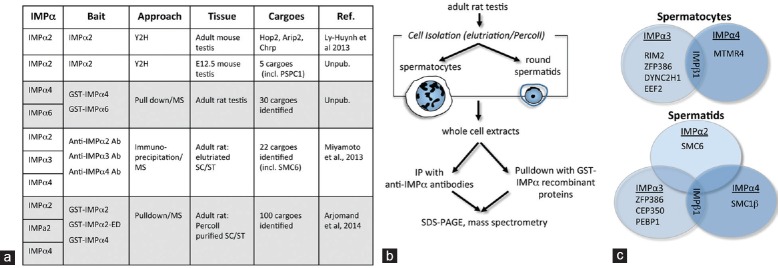Figure 2.

Identification of importin-binding proteins of relevance to spermatogenic differentiation. (a) Table outlining the different approaches used to identify IMPα-specific cargoes. Yeast 2 hybrid (Y2H) screening was used to identify over five specific, validated IMPα2 cargoes. Around 130 protein cargoes were identified using recombinant IMPα proteins tagged with GST in pulldown assays from lysates of whole adult rat testis or from Percoll-purified spermatocytes (SC) and spermatids (ST). An antibody-based immunoprecipitation (IP) approach, followed by mass spectrometry (MS) led to identification of up to 22 proteins specific for the different IMPαs. (b) Schematic of isolation processes leading to identification of cargoes from isolated germ cell subtypes. The most comprehensive studies to date have used pulldown assays with GST-conjugated recombinant IMPα proteins or immunoprecipitation from isolated spermatocyte or round spermatid lysates, followed by cargo identification through mass spectrometry.19,32 Around 130 IMPα binding proteins were identified using this approach. (c) Immunoprecipitation from spermatocytes and spermatids reveals different cargoes bound by each IMPa protein at specific stages of spermatogenesis.19 Examples listed include both nuclear and non-nuclear proteins. IMPα3 and IMPα4 both bind to IMPβ in spermatids and in spermatocytes, as expected, but each binds cargo subsets that are distinct in each germ cell type. This approach also identified common IMPα-specific cargoes: for example ZFP386 was identified as an IMPα3 cargo in both spermatocyte and spermatid lysates.
